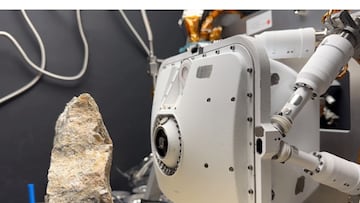Here’s how NASA is using AI to study Mars
While NASA’s rover missions on Mars are sampling rocks, at the same time they are helping develop technology that will lead to future “smart” spacecraft.

Artificial intelligence, while there are concerns about its dangers it holds much promise as well. And not just here on Earth but in our endeavors to explore ever further out into space. NASA, for the past eight years, has already been using AI on two of its rover missions on the Red Planet.
While Curiosity and Perseverance still require dozens of engineers and scientists to input hundreds of individual commands for each day’s work, the “digital smarts” boost their ability to get more done in less time. The dream is that the advances in AI achieved with the rovers on Mars will lead to “smart” spacecraft in the future which can explore planets.
Here’s how NASA is using AI to study Mars
Curiosity, which landed on Mars in 2012, didn’t travel to the Red Planet with its AI suite of software but got the upgrade in 2016. The new digital smarts gives the rover the ability to carry out scientific investigation when it reaches a new destination without waiting for instructions from its handlers on Earth.
The AEGIS software, or Autonomous Exploration for Gathering Increased Science, has allowed the rover to target rocks that it deems of interest with its laser to zap. Curiosity’s ChemCam can then perform a spectrographic analysis of the minerals and elements in the resulting gases.
“Time is precious on Mars,” said Raymond Francis, lead system engineer for AEGIS’ deployment on the Curiosity rover. “AEGIS allows us to make use of time that otherwise wasn’t available because we were waiting for someone on Earth to make a decision.”
AI is everywhere, even on Mars.@NASAPersevere is using artificial intelligence that looks for minerals in rocks. This "adaptive sampling" software uses the rover's PIXL instrument to make autonomous decisions based on real-time analysis: https://t.co/TUmXco5fPK pic.twitter.com/aqlwrFCS0p
— NASA JPL (@NASAJPL) July 16, 2024
In 2020, NASA sent the Perseverance rover to the Red Planet packing PIXL, which is a precision X-ray device that is powered by artificial intelligence. The acronym stands for Planetary Instrument for X-ray Lithochemistry, which is an instrument roughly the size of a lunch box located on the end of the rover’s 7-foot-long robotic arm.
The digital smarts on Perseverance is a more advanced form of AI than Curiosity’s. The software that is dubbed as “adaptive sampling” autonomously positions PIXL close to a target rock, analyzes the scan to find minerals on the target that are worth further investigation.
“We use PIXL’s AI to home in on key science. Without it, you’d see a hint of something interesting in the data and then need to rescan the rock to study it more. This lets PIXL reach a conclusion without humans examining the data,” said the instrument’s principal investigator, Abigail Allwood.
Related stories
“PIXL’s X-ray beam is so narrow that it can pinpoint features as small as a grain of salt,” explains the NASA scientist at the Jet Propulsion Laboratory. “That allows us to very accurately tie chemicals we detect to specific textures in a rock.” This will help researchers decide which samples are worth bringing back to Eart to study.
Additionally, Perseverance’s handlers on Earth don’t have to dictate every single detail for the rover to travel from point A to point B. They plan out a general route but the six-wheeled geologist can work out the finer points of navigating which allows it to cover terrain in much less time than other Mars rovers.



Complete your personal details to comment